The development of information technology and the computerization of the population have made the desk the place where one spends almost all day in this position. The feeling of pain and discomfort in the spine almost every second person knows. Pain in the spine, limbs, numbness in the legs are the main signs of osteonecrosis. Moreover, if in the past people over 40 years old suffered from osteonecrosis, today teenagers have to face this disease when they are in high school.
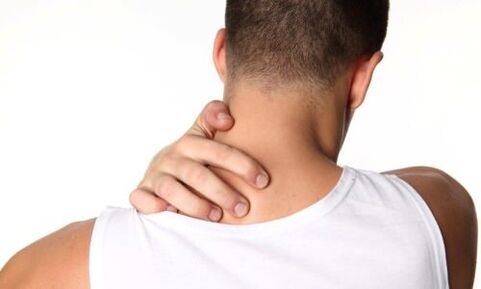
According to localization, osteonecrosis is divided into several types - cervical, thoracic and lumbar. One of the most common types of disease is called cervical osteochondrosis. It should be said that, due to its localization, it causes complications in the work of the brain, is fraught with neurological diseases. From our article you will learn in detail about this disease, its course, features of treatment and prevention.
Causes of cervical osteonecrosis
It may sound a bit strange, but the cause of spinal tumors is… human life. Any excessive load on the spine leads to some deformity, which is why the disease occurs. Osteosarcoma can be prevented or cured, but only if it does not run. And for those lucky enough to be pain-free, I'd like to warn you: analyze how much stress is on your spine - and you'll understand if you're at risk for osteonecrosis.
Thus, the main and most common cause of osteonecrosis in adults can be work-related, including the constant lifting of heavy objects, such as the work of a loader. In addition, the disease can arise from "sedentary" in the office or "manual" work, such as for a salesperson in a certain position for long periods of time, which creates a load on thebody, parts. of the spine.
There is a risk of osteonecrosis in athletes from carrying heavy loads or, conversely, due to poor physical development in people who do not play sports at all. There are cases where the disease starts even when athletes are actively training, then suddenly stops suddenly. Not to mention spinal trauma, which later leads to osteonecrosis. Can affect the spine and flat feet, when due to the abnormal shape of the foot, the load on the vertebrae and discs are distributed differently, creating inconvenience.
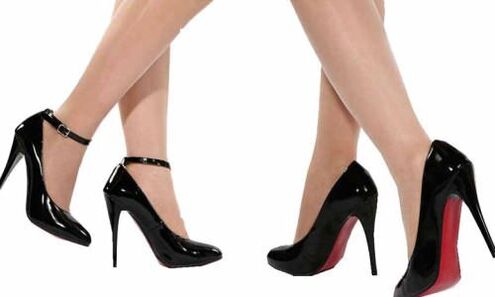
Perhaps osteonecrosis in pregnant women due to the same increased load, as well as in women who often walk on tiptoes, overwork the spine.
The causes of cervical osteosarcoma can be hereditary or hereditary.
Diseases of the spine can manifest due to impaired metabolism in the body, obesity, poor immunity, toxicity, infectious diseases that reduce the function of the spine.
Over the years, the spine becomes more fragile, losing the elasticity of the discs, bone density, and deformity. Age is another cause of osteonecrosis.
And finally, the impact on the spine of the environment and living conditions cannot be discounted. Bad ecology, stress, nutrition, not rich in vitamins and trace elements - all this can also provoke the development of cervical osteochondrosis. Symptoms of cervical spondylosis are quite pronounced. They need to be known to prevent the development of the disease in time. After all, each of us has a share of risk.
Symptoms and stages of the disease
You can recognize osteonecrosis with a simple exercise - turning the head. Pain when turning is the first sign of cervical necrosis. Subsequent symptoms are muscle spasms, difficulty in movement, numbness in the fingers, and shoulder pain.
This type of disease is called lens syndrome or cervical sciatica. It occurs if the nerve roots are compressed by the vertebrae due to a violation of their position, the appearance of a hernia. The pain in this case subsided in waves from the shoulder to the fingers, tingling sensation in the fingers and forearms. If the pinky and ring fingers are numb, it means the brachial nerve is affected, which is the area of 7-8 vertebrae. If the remaining three fingers - the problem is located in the 5-6-7 vertebrae region, then the central nervous system is affected.
In addition, the disease also has symptoms related to brain activity. The headache often recurs with very intense or painful cervical osteochondrosis. Perhaps dizziness with cervical osteochondrosis, tinnitus, spots in front of the eyes, blurred vision, hearing, dental problems. These signs of the disease suggest an effect on the two vertebral arteries that carry blood to the brain. In particular, in the areas responsible for blood pressure, in the area of the cerebellum, which controls our vestibular apparatus. This type of disease is called vertebral artery syndrome and is very common. Osteoma of the cervical spine, affecting the arteries, leads to a violation of normal mobility and even a stroke.
There are also excitatory reflex syndromes. In this case of cervical osteonecrosis, the symptoms are similar to those of other types of disease, but the pain occurs suddenly after rest. For example, when a person wakes up from sleep, he feels a dull pain in his neck.
Another type of illness is very similar to heart disease - angina, when pain occurs in the chest and radiates down to the shoulder, lasting for several hours. This is a heart syndrome. Cardiac imaging will help distinguish osteonecrosis from heart disease, thereby confirming that blood circulation is not disturbed and the patient is worried about the spine, not the heart.
Cervical osteosarcoma is divided into stages of the disease. At the initial or preclinical stage, there is little internal change at the biochemical level. A person feels some inconvenience for long periods of time in one position, on exertion. The muscles in the back and neck quickly get tired.
The second stage of the disease is called the progressive phase of changes in the nucleus pulposus. At this time, the disc is deformed, the metabolism in the nucleus pulposus is disturbed, some of its cells die. As a result of these processes, the distance between the vertebrae is gradually reduced, resulting in the nerves being pinched and constricted. A person feels pain in damaged areas of the spine.
In the third stage of the disease, complete or partial destruction of the annulus occurs. Cracks appear through which the nucleus pulposus exits, violating the tightness of the connection of the vertebrae. The spine becomes abnormally mobile, the vertebral segments are displaced. This causes pain in the entire back, movement disorders, and loss of sensitivity in the extremities.
And the most severe, the fourth stage of osteonecrosis, is manifested by the regeneration of the vertebral discs, the so-called fusion of the vertebrae. The nucleus pulposus replaces the cartilage, pain is reduced, and the spine is restored to support. But, unfortunately, the consequences of such changes in the spine are limited human mobility and even disability.
The spine has three important functions in the human body. These are the ones that support, protect the spinal cord, and wear it out during movement. Our ability to move freely and survive depends on the spine. Back pain should not be viewed as a temporary and random phenomenon. Follow the rule: if you feel pain when turning your head gently, you should contact a neurologist.
Bone tumors in children
Osteoma in children is not as common as it is in adults, and is a congenital or inherited disease. But since the deformation of the spine can lead to bad consequences and cause great harm to the child's physical development, we decided to highlight this topic separately and draw the attention of theparents to osteonecrosis in children.
Children's spine is more sensitive to injuries, freezing, lack of nutrients to form and develop. And this, as already mentioned, is the cause of osteonecrosis. Therefore, it is important to pay attention to the child's nutrition, remembering that it should be rich in calcium and other trace elements, diverse and useful. In the case of injuries and falls on the back, especially at a young age, it is imperative to consult a doctor for an examination and, if the disease has been identified, further treatment can be given. By the way, osteonecrosis in children can be a consequence of congenital trauma.

Osteoarthritis occurs in childhood and is hereditary, when the fragility of the vertebrae is passed on genetically. If, in the case of spina bifida in children, the region of bone growth is affected, i. e. the area where the bones grow, this can also lead to a decline in the child's overall growth and development. Symptoms of osteonecrosis in children are similar to those in adults, but the pain is more moderate, and movement is not disturbed. With cervical osteochondrosis, fainting, dizziness may occur.
If your child has a predisposition for osteonecrosis or you suspect a back problem, seek medical advice immediately. The earlier the disease is detected, the sooner you can cure it.
Diagnosis of osteonecrosis of the cervical spine
Diagnosis of cervical osteosarcoma, like other diseases, begins with an examination of the doctor. In this case, a neurologist. Doctors examine patients in many different positions - standing, sitting, lying down, checking the state of the spine when moving. Draw attention to the posture, the position of the mediastinum of the back, the position of the shoulder blades, the shoulders. In addition to visual inspection, tactile inspection is also a must. The location of the lesion is found, guided by complaint, examination, and also using a special technique to count the vertebrae. In addition, the patient is also assigned to take X-ray or magnetic resonance to examine the spine more closely, find out the stage of damage. After diagnosis, treatment of cervical spondylosis is prescribed.
The treatment
Treatment of cervical osteonecrosis is often complex. Usually, it is based on a few imperative points. One of the main things is the correct engine mode. Literally move without jerking your head. Any rapid movement is not beneficial for the vertebrae. Your doctor will most likely order a special medical-grade soft collar to immobilize your neck for the duration of your treatment.
To see something from his own side, the patient should turn his head slowly. If you feel discomfort in your neck, do some special exercises, give yourself a massage.
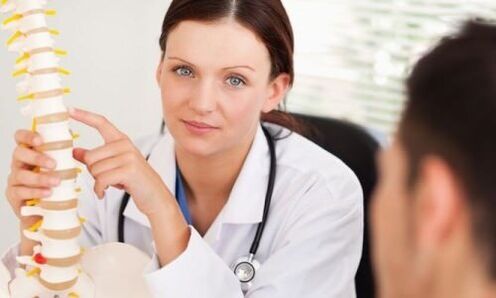
A mandatory stage in the treatment of osteonecrosis in the acute stage is drug administration. Your doctor will prescribe non-steroidal anti-inflammatory drugs to eliminate the foci of inflammation and swelling. Be sure to help ease the process of pain relief. If osteonecrosis is causing muscle spasms, a medication is also prescribed to relieve cramps and relieve pain. B vitamins will also be prescribed, which help improve brain function, help fight stress, and strengthen muscles. And if the patient falls into a state of depression, an antidepressant will be prescribed.
You can not do without treatment of osteonecrosis without external preparations - gels, ointments, creams. Known anti-inflammatory drugs act directly at the heart of the disease. There are ointments called chondroprotectors, that is, ointments with components that restore the cartilage tissue of the disc. And, of course, patients will need ointments or creams for therapeutic massage, which is also indispensable.
Manual therapy for osteonecrosis
Many patients with osteonecrosis seek the help of orthopedists. This treatment may be included in the complex if the patient has anatomical changes in the spine, herniation or disc displacement occurs. With the right treatment, it really gives positive results. But when looking for a professional, be careful. Before agreeing to treatment, make sure the specialist has a medical degree and practices traditional treatment, and has completed additional training in the specialties of neurologists and neurologists. orthopedic, and has a certification certificate. Operator experience is also important. After all, the therapy itself requires obvious movements and, if used improperly, can lead to injury. The principle of manual therapy is to target the structural components of the spine. With a quick push, the joint has moved from the correct position back to the joint. There is no doubt that appropriate therapy is a very effective treatment for cervical osteochondrosis.
Physical therapy
Therapeutic exercises for cervical spondylosis will allow you to fight this disease even at work. Moreover, simple exercises will be a great way to prevent spinal diseases.
So take your eyes off the screen, lean back in your chair, and learn some helpful exercises.
Sit in a chair, placing your feet shoulder width apart. Relax, put your hands down. Slowly lower your head until your chin touches your chest. If it fails, that's okay, bring it down as much as possible, as much as possible. Then, slowly raise your head and tiptoe back, also until you come to a complete stop. Return to the starting position with your head straight, and repeat the exercise 5 times.
Without getting up from the chair, gently turn your head to the side. First in one direction, then return to the starting position and turn in the other direction. 5 times each time.
Turn around, can go to the mountainside. The exercise is also performed while sitting, slowly tilting the head to the left, then back, and then to the right. They bowed their heads as hard as they could, trying to put their ears on their shoulders. The exercise is performed at least 5 times on each side.
It will help stretch the neck muscles and the following exercise. In a sitting position, slowly turn your head back, hold this position for a few seconds, and slowly begin to turn your head to the left, then to the right, at least 10 times.
You can also, without leaving the workplace, perform an exercise to warm up the muscles in your shoulders. Sitting in a relaxed position, begin to rotate your shoulders 5 times forward, then 5 times backward. Do this slowly and carefully, feeling each muscle.
It will help stretch your shoulders and the exercise is known to everyone since kindergarten. It can be done as desired - sitting or standing, as the situation allows. You slowly swing your left hand over your shoulder to the right, touch your ear with your finger and then lower it. Bring your right hand in the same way over your head to your left ear.
Now do a little more warm-up for the neck muscles. Bring your palm to your forehead, start pressing your forehead to the palm of your hand, supporting your hand. Hold this pose with your neck stretched and count to 5. Then relax and repeat the exercise twice.
The exercise is similar to the previous one. But now the other cervical muscles will work. You throw your hands or more conveniently, both, folded in a padlock, behind your head, place them behind your head and start pressing your head on your hand. Do the exercise 3 times in 5 seconds.
Now we stretch the lateral muscles of the neck. There is only one plan - head against hand, hand against. You put your left hand on the left temple, press, count to 5, rest for a few seconds and repeat 2 more times. Likewise, the exercise is performed for the right side of the neck.
And finally, a little warm-up in a standing position. It is better to choose an empty space in the office for this. Place your feet shoulder-width apart for better balance. With their arms outstretched in a free state, they began to rotate synchronously 5 times forward, then 5 times backward.

After resting for about 10-15 minutes, you will feel the muscle tension in your back and neck lessen, take a break from the screen, relax a bit. Such breaks are useful, and in many modern offices, they even practice co-workers in mass exits to warm up. Don't ignore the simple rule - warm up every time you're tired and stressed. Gymnastics for cervical warts is an excellent treatment for the early stages of the disease and effective prevention. In more severe cases of the disease, a course of exercise (physical therapy exercises) is prescribed.
Therapeutic exercises for cervical osteonecrosis
Exercise therapy for cervical osteochondrosis is simply irreplaceable. A variety of exercises will improve the function of the spine, help maintain muscle continuity and reduce stress. Exercising will require some spare time and a warm exercise mat on the floor. They can be done at home in the evening or in the morning before work. Of course, it is recommended to do this between meals.
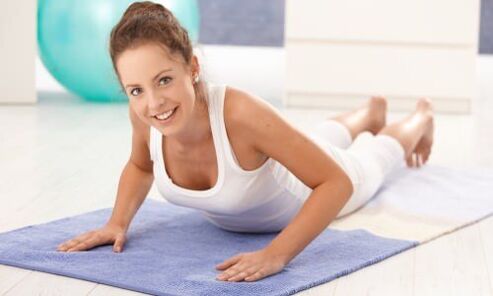
Lie on your back on the floor, stretch your arms along your body. Look forward and begin to look away to the right and left, four times each. After looking sideways, start looking up and down four times as well. After finishing the side warm-up, proceed to the rotation of the eyes immediately in a clockwise direction, and then in the opposite direction.
In the same lying position, turn your head in different directions. Slowly, slowly. After doing 4 reps each way, proceed to tilt your head to the left and to the right shoulder.
You can do exercises with a head lift. Alternatively, lie on a flat surface, lifting your head off the floor and leaning toward your chest, trying to touch your chest with your chin. Pull your head as close as possible. All this without sudden movements no more than 4 times.
When performing exercises to cure cervical spondylosis, you need to remember that not only the cervical area but the whole body needs to be warmed up. Therefore, lying on your back, after completing the first simple exercises, have warmed up, continue to the next exercises. Spread your arms out to the sides and turn to one side, trying to touch the opposite side with your arms and legs but not on your stomach. Turns are performed on inhalation, and they return to the original position on exhalation. Do not more than 5 turns.
The next exercise is to sit down from a prone position. Lying on the floor with your arms extended along your body, you need to slowly rise up, hands on. A rather difficult exercise for osteonecrosis, so we emphasize again that you need to do this move carefully and slowly, 3-4 times.
Lie on your back, bend your legs and press on your stomach, hugging your knees with your hands. Then gently pull your head toward your legs and touch your knees. Furthermore - also carefully return to the prone position. The exercise is performed up to 5 times.
You are lying down, knees bent at the waist level, arms outstretched. Alternately turn right and left up to 5 times in each direction.
Do not interfere with abdominal exercises. Turn over and stretch your arms along your body. Start by lifting your head off the floor, then your shoulders and torso, focusing on your legs and hips. Then return to the starting position and perform the exercise up to 5 times.
Breathing exercises are very useful for cervical osteonecrosis. After resting a bit from the previous exercises, lie on your back, folding your arms on your stomach. Breathe in deeply and slowly, blow out your belly, exhale carefully, draw your belly in. Do 5 breaths and exhalations.
Place one hand on your stomach and the other on your chest. Inhale deeply, stretch, exhale, relax. The number of breaths is also 5 times.
These exercises are indicative only and should not be considered a complete treatment. Rather, these are recommendations for preventing the disease or its development. Exercises to treat cervical osteosarcoma are selected by the doctor based on the patient's needs.
Self-massage
Massage is one of the necessary and pleasant procedures during the treatment of warts and is prescribed by a doctor. Of course, trying to professionally repeat massage at home, with the participation of loved ones, is really only handled by medical professionals. But the light kneading can be done on its own, keeping you distracted in the middle of the workday and reducing stress. By the way, massage will be a good addition to gymnastics.
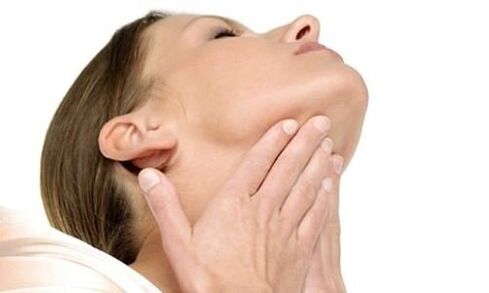
So, when you feel neck pain, lean back in the chair, relax your back. The massage begins with stroking the neck with the palm of the hand from top to bottom, that is, from the hair to the shoulders. After swiping, rotate the palm to the edge of the neck and move the hand from top to bottom several times, pressing lightly. Then start grinding. Place your palms at the back of your head so that your fingers converge centered on the spine. Rub the body, move the hands from the middle of the vertebra to the sides of the neck, down from top to bottom. You can use your fingertips to massage your neck, massaging in a circular motion. Then, begin to pinch the skin and muscles, pinching them between the index finger and the thumb. And then stroke the neck with the palm of your hand, completing the massage.
Self-massage for cervical spondylosis will help relieve pain and muscle tension.
Treatment with folk remedies
The most popular folk remedies for any disease are herbal preparations. Treatment of cervical fibroids with folk remedies is possible in the initial stage of the disease. Herbs like mint, St. John's wort, calendula, yarrow, licorice root, chamomile, birch and strawberry leaves help fight diseases of the musculoskeletal system. Make tea from these herbs, drink regularly, as a tonic and a means of prevention.
You can also take herbal baths. Each bath you need at least 300 grams of dry plants. Pine bath helps a lot. Finely ground coniferous leaves, pour boiling water and stir for 20 minutes. It is then filtered, put in a hot bath and steamed in it for up to half an hour.
You can and should take a bath from chamomile, which has a perfect anti-inflammatory and healing effect on the body. Chrysanthemums are poured with boiling water, insist for up to an hour, strain and add to the water.
Quick compresses from customized means will help relieve back pain. Everyone has potatoes and honey in the house. Recommended folk methods for making such a medicine: grate the vegetable and mix it with honey in a ratio of 1: 1. The composition is applied to the gauze and applied to the sore spot. Relief is assured, but, alas, not for long.
Ginger and garlic ointments work the same way. They are rubbed on an overlock machine and combined in a 1: 1 ratio, adding a little butter or kerosene to be able to lubricate and rub the sore spot. It will also reduce pain and inflammation, but it will not cure the disease. With osteonecrosis, it is imperative to visit a neurologist, the doctor will prescribe definitive treatment.
Finally, I want to talk about the basic rules of behavior for osteonecrosis. First, keep your back straight and your head straight. Set up your workspace by these standards, from placing a book under your monitor if it's low or finding a higher chair.
Do not lift heavy objects unless absolutely necessary. And if you really have to carry a heavy load, pick up the weight not in a crouching position, but do it like weightlifting with a barbell - sit down and then get up with a load.
Do not overcool the back, avoid drafts. A wide range of vest styles and fashion options will keep your back warm at any time of the year and under any circumstances.
Move more, do swimming, exercise, hang on the crossbar.
Having grasped all the secrets of gym, self-massage and prevention of cervical spondylosis with folk remedies, please share it with your office friends. So you can not only protect yourself against spinal diseases, but also help your colleagues avoid back pain and increased fatigue. Be healthy!
























